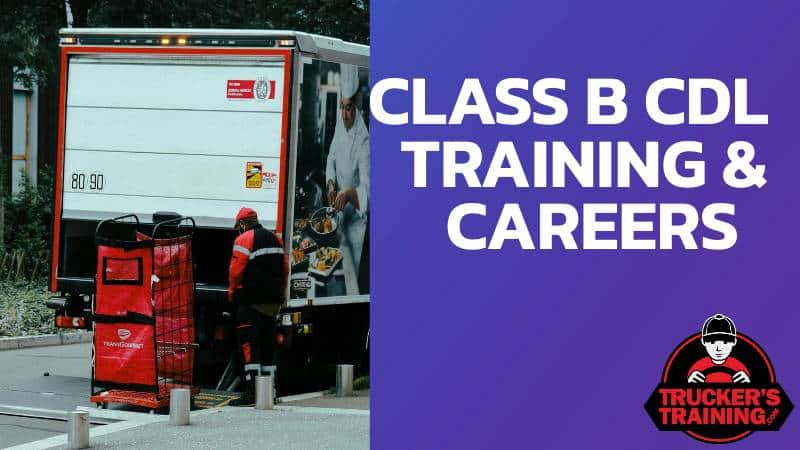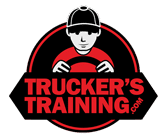
If you are interested in driving for a living, but prefer to be home most nights instead of being on the road, then you might be interested in getting your Class B commercial driver’s license.
With a Class B CDL, you can transport heavier cargo and drive bigger vehicles, deliver goods, shuttle people around, transport waste materials, or operate heavy equipment. The Class B license provides a path to many in-demand jobs with decent wages.
This guide will walk you through everything you need to know about obtaining your Class B CDL, the training involved, job options available, average salaries, and more.
What is a Class B CDL License?
To operate a Class B commercial vehicle, you’ll need to obtain a Class B commercial driver’s license (CDL). This license allows you to drive any single vehicle with a gross vehicle weight rating (GVWR) of 26,000 or more pounds, or any such vehicle towing a trailer not heavier than 10,000 pounds.
Class B vehicles typically include:
- Dump trucks
- Garbage or sanitation trucks
- Straight trucks
- Courier or delivery trucks
- Large passenger vans
- Buses: transport buses, city buses, school buses, tour buses, segmented buses
- Trucks with trailers (if the trailer is 10,000 lbs. or less)
Endorsements and Restrictions
To drive a Class B vehicle, you’ll need the proper endorsements and need to be aware of any restrictions. Endorsements are add-ons to your CDL that allow you to haul certain types of cargo or passengers.
Restrictions may prohibit you from hauling cargo, or going outside a certain radius, among other things. They are meant to ensure you gain enough experience before taking on more difficult driving. Some states may also have their own restrictions on your CDL. For example, Utah requires that class B drivers wear corrective lenses.
Following the rules regarding endorsements and restrictions will help keep you and others safe on the road. Once you meet the requirements, you can have certain endorsements or restrictions removed.
Class B CDL Training
To obtain your Class B CDL (and/or Class A CDL), you’re required to complete an Entry-level Driver Training (ELDT) as mandated by the FMCSA. A Class B CDL training typically takes 2 to 6 weeks to complete, depending on if you study part-time or full-time. The curriculum will cover general truck driving knowledge, safety standards, and hands-on practice driving a Class B vehicle like a straight truck or small bus.
To obtain your CDL, you’ll also need to pass knowledge tests on general trucking knowledge and specific Class B topics, as well as a driving skills test in a Class B vehicle. After passing the knowledge tests, you’ll demonstrate your ability to properly and safely drive a Class B vehicle during an on-road skills test with an examiner. With the necessary training, knowledge test, and skills test complete, you can apply for your Class B CDL at your local DMV.
| Class B CDL ELDT Curriculum Requirements | ||||||
|---|---|---|---|---|---|---|
| THEORY | ||||||
| Basic Operation | Orientation | |||||
| Control Systems/Dashboard | ||||||
| Pre- and Post-Trip Inspections | ||||||
| Basic Control | ||||||
| Shifting/Operating Transmissions | ||||||
| Backing and Docking | ||||||
| Safe Operating Procedures | Visual Search | |||||
| Communication | ||||||
| Distracted Driving | ||||||
| Speed Management | ||||||
| Space Management | ||||||
| Night Operation | ||||||
| Extreme Driving Conditions | ||||||
| Advanced Operating Practices | Hazard Perception | |||||
| Skid Control/Recovery, Jackknifing, | ||||||
| and Other Emergencies | ||||||
| Railroad-Highway Grade Crossings | ||||||
| Vehicle Systems and Reporting Malfunctions | Identification and Diagnosis of Malfunctions | |||||
| Roadside Inspections | ||||||
| Maintenance | ||||||
| Non-Driving Activities | Handling and Documenting Cargo | |||||
| Environmental Compliance Issues | ||||||
| Hours of Service Requirements | ||||||
| Fatigue and Wellness Awareness | ||||||
| Post-Crash Procedures | ||||||
| External Communications | ||||||
| Whistleblower/Coercion | ||||||
| Trip Planning | ||||||
| Drugs/Alcohol | ||||||
| Medical Requirements | ||||||
| Behind-the-Wheel (BTW) Range | Vehicle Inspection Pre-Trip/Enroute/Post-Trip | |||||
| Straight Line Backing | ||||||
| Alley Dock Backing (45/90 Degree) | ||||||
| Off-Set Backing | ||||||
| Parallel Parking Blind Side | ||||||
| Parallel Parking Sight Side | ||||||
| Behind-the-Wheel (BTW) Public Road | Vehicle Controls Including: Left Turns, Right Turns, Lane Changes, Curves at Highway Speeds, and Entry and Exit on the Interstate or Controlled Access Highway | |||||
| Shifting/Transmission | ||||||
| Communications/Signaling | ||||||
| Visual Search | ||||||
| Speed and Space Management | ||||||
| Safe Driver Behavior | ||||||
| Hours of Service (HOS) Requirements | ||||||
| Hazard Perception | ||||||
| Railroad (RR)-Highway Grade Crossing | ||||||
| Night Operation | ||||||
| Extreme Driving Conditions | ||||||
| Skid Control/Recovery, Jackknifing, and Other Emergencies | ||||||
| Source: FMCSA |
Classroom Training
Classroom training is a key part of obtaining your CDL. In a classroom setting, you’ll learn the basics about safe driving practices, vehicle controls, and inspecting your rig.
Experienced instructors will teach you everything you need to know to pass the written general knowledge test and endorsement tests for the type of CDL you want to obtain. Pay close attention and ask questions if there’s anything you don’t fully understand. The more you comprehend now, the more confident you’ll feel behind the wheel.
Taking notes, studying the course materials, and practicing sample tests will help prepare you for the actual written exams.
Driving Range
You’ll also need to demonstrate that you can safely operate a commercial motor vehicle (CMV) in a variety of situations. During your driving skills test, the examiner will evaluate how well you handle a range of driving maneuvers.
You’ll do basic skills like starting, stopping, turning, and parking. You’ll also perform more complex demonstrations such as alley docking – backing the vehicle into an alley or narrow area. The examiner will check that you properly secure any cargo or freight, following all safety procedures.
To prepare, get as much practice time as possible driving a Class B vehicle. Work with an experienced instructor or mentor who can give you tips and pointers.
Road Training and Testing
Additionally, you’ll need to complete a road test to demonstrate your ability to safely operate a commercial vehicle. During your road training, an instructor will teach you skills like conducting vehicle inspections, turning, merging, changing lanes, and emergency braking.
You’ll get hands-on experience driving a Class B vehicle like a straight truck or small bus. Once you and your instructor feel you’re ready, you can schedule your road test.
Where to Begin Class B CDL Training
There are a few options for beginning your Class B CDL training.
Truck Driving Schools
CDL training programs at truck driving schools prepare you to obtain a Class B CDL license. These schools usually offer flexible class schedules and training courses that last 2 to 6 weeks. Some schools even help place you in an internship or entry-level job after you complete the program and earn your CDL.
Community Colleges
You can also get your Class B training at community colleges. These programs are often cheaper compared to curriculums at truck driving schools. Training covers all the knowledge and skills needed to pass the required CDL exams.
On-the-Job Training
On-the-job Class B training with an employer is another possibility. Some trucking companies hire driver trainees and provide paid on-the-job training to prepare for a Class B CDL. You’ll learn while earning a paycheck and be ready to advance to a full-time truck driver position after completing the training.
Class B CDL Careers
As a holder of a Class B CDL, you’ll have access to various driving jobs that allow you to operate larger vehicles. Some of the most common careers include:
- Delivery driver: Transport packages, supplies, or goods between locations for shipping companies like UPS or FedEx. Requires loading and unloading the vehicle and ensuring items are delivered on time.
- Shuttle driver: Drive passengers between locations like airports, hotels, and convention centers. This may involve helping riders with luggage and ensuring a safe, comfortable ride.
- Bus driver: Transport passengers on routes within cities or between cities and states. Requires ensuring riders pay the proper fare, are safely seated, and arrive at their destinations on schedule.
- Waste management driver: Collect trash, recycling, and yard waste from residential and commercial customers. Involves loading waste and transporting it to disposal or processing sites. Requires physical ability for frequently getting in and out of the vehicle and moving waste containers.
- Cargo van driver: Transport goods, packages, or equipment for businesses. This may involve assisting with loading and unloading cargo and ensuring items are delivered according to strict schedules and routing.
The job opportunities are plentiful with a Class B CDL. With the proper training and experience, you can find a rewarding career driving vehicles you’re passionate about.
How Much Do CDL Class B Jobs Pay?
The pay for CDL Class B jobs can vary depending on factors like your location, experience, and specific job responsibilities. According to ZipRecruiter, the average salary for Class B drivers in the U.S. is around $49,345 per year. Experienced drivers and those in high-demand areas may make more. Many trucking companies also offer additional benefits like health insurance, paid time off, retirement plans, and job security.
Benefits of a Class B CDL Job
A Class B CDL opens up many opportunities for stable, well-paying jobs. Some of the major benefits of a career with a Class B license include:
- Job security. There is a shortage of commercial drivers, so the job market is strong. Many companies offer sign-on bonuses and competitive pay to attract qualified applicants.
- Good pay. Experienced drivers and those in certain niches like hauling hazardous materials can also make significantly more than a regular class B driver.
- Variety of options. You can drive many types of commercial vehicles from dump trucks to shuttle buses and delivery trucks. There are jobs to match most preferences.
- Valuable skills. Driving a large commercial vehicle requires training and expertise that translates across companies and locations. Your CDL and experience open up more opportunities for career growth over time.
- Adventure. For those who enjoy travel, over-the-road driving jobs provide an opportunity to see the country from the open road. While challenging, many drivers find it a rewarding lifestyle.
A Class B CDL can lead to a stable career with good compensation, opportunity for growth, and a variety of work options to suit your interests. The job security and valuable, transferable skills make it an attractive field for many.
Conclusion
This is the ultimate guide to getting your Class B CDL and finding a fulfilling new career. While the training and licensing process may seem extensive, staying focused on the opportunities ahead can help motivate you. With a Class B CDL, a whole new world of options opens up, from local delivery driving to over-the-road trucking. The key is to find the right role and company culture for you based on your priorities and needs. A career as a commercial driver can be demanding yet rewarding, allowing you to see the country while earning a solid paycheck.

Sasha is a freelance writer for TruckersTraining.com and an entrepreneur. She has 10+ years experience as a writer with expertise in the transportation, business and farming industry. She is a wife, a mother, and co-owner of DreCampbell.com.
